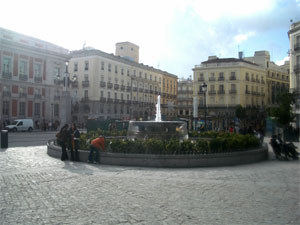Semester at
Sea Fall
2006 Voyage 
- Home Page
- My Bio
- Comparative Global
Cities Project: From Slums to Starbucks
- The Japanese City: Modern and
Traditional
- Vietnam: Vernacular at Heart
- Myanmar: Poor in Wealth; Rich in Culture
- India: A World of Contradictions
- Egypt: Cairo: A Globalizing City
- Spain:
Madrid: Old Beauty Mixed with Modernity
- Open Letter
Madrid: Old Beauty Mixed With
Modernity
As I stepped off of the MV Explorer, and
took my first few
steps onto Spanish soil, I was filled with many conflicting feelings. I was so excited to be in Spain, however, I
was very sad knowing that it was our last port. As
a result, my friends and I decided that we had to do something
special in Spain. So, we ended up
taking an eight-hour, overnight bus up to the capital city of Madrid.

From the
moment that I stepped off of the bus in Madrid, I realized that I was
in a city
that was far different from any of others that I had visited on
Semester at
Sea. The streets of Madrid seemed to be
very old, and rich in history and vernacular architecture.
Many of the sidewalks were made of brown
cobblestone, and many of the buildings were built with old brick with
very
detailed architecture. It was easy to
see that the heart of Madrid had been built long ago.
However, to contrast the very old feel of the city were the Spaniards, who walked the city streets. The people of Spain were very fashionable, very modern, and very global. As I sat on the metro and other trains I heard a countless number of cell phone rings. While shopping on one of Madrid’s main roads I saw many people carrying to-go Starbucks coffee carriers. The Starbucks coffee carriers symbolized that Madrid is becoming a very global city because traditionally coffee in Spain was always enjoyed sitting down at a café. It made me realize that Western, American culture is seeping into Spain, and may not be influencing it in a positive way.
Another way
I
could tell that
Madrid was a global city was by viewing its minorities.
Since Spain is so close to northern Africa,
many immigrants come to Spain to create a better life.
Unfortunately, as Liliana Suarez-Navaz
writes in her article, Rebordering the
Mediterranean, many of these new
immigrants are experiencing high amounts of discrimination. This
problem,
however, is not unique to Spain. Many
Global cities in the western hemisphere are the places in which people
from
poverty stricken countries wish to immigrate to. Unfortunately,
saw many people who looked to be African
descendents, living in poverty on the streets of Madrid.
In conclusion, the city of Madrid is no doubt a global city. It has global corporate chains on every street block, cell phones ringing constantly, and minorities pouring in from less fortunate countries. However, though Madrid is becoming increasingly global, it still retains much of its vernacular charm, such as beautiful architecture. Hopefully, as Madrid continues to change and become more transnational, its people will find a way to retain their culture while finding a way to accept new immigrants at the same time.